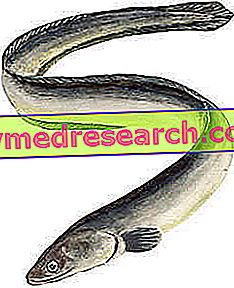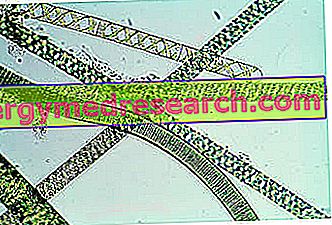Generality
The Italian eel is the same species ( Anguilla anguilla called "European eel") that colonizes the inland waters of the Old Continent, before migrating towards the Sargasso Sea crossing the Mediterranean and then the Atlantic Ocean; it is a bone fish that can easily survive in both fresh and salt water.

The eel has very fatty but also very fine meats and in the last 50-60 years its presence has been so reduced (due to multifactorial causes) that it is classified among the endangered species.
Description
The eel has a smooth skin, completely covered with mucus and apparently without scales (which in reality are very small). The skin pigments of this fish change in an inter- and intra-individual manner based on the stage of sexual maturation and / or habitat.
The specimens caught in fresh or brackish water have a brown or green color on the back, while the belly is yellow. The mature eel, or rather ready to make the migration, becomes black on the back and yellow on the belly; moreover, as the long journey for reproduction continues, it takes on quite different physical characteristics (which give it the name of "Argentinian eel") compared to freshwater specimens.
The fresh or brackish eel has a long anal fin that joins first to the caudal fin and then extends up to the back; the pectoral fins are rather small. The gills of the eel are minute, the mandible is prognathed (even in the migrant specimen) and the eye appears to be quite underdeveloped. That being said, let us mention some morphological traits that vary in the Argentine eel: the micro-scales increase in size, the pectoral fins grow, as well as the eyes, while the head becomes considerably thinner; everything leads us to believe that this is an evolutionary process designed to improve its abyssal swimming capacity.
The European eel has a very poor sight and uses it mainly in order to capture the light from which it hides (it is a mainly nocturnal fish that moves mainly with the absence of the moon), a sense that improves during migration; in hunting it mainly uses the sense of smell and probably the perception of vibrations in the fluid. For hunting, the eel makes use of powerful jaws equipped with small conical teeth useful for preying: worms, annelids, molluscs, crustaceans and all kinds of fish; it also has necrophagous and scavenger abilities.
The eel reaches different sizes based on sex; the female can reach over a meter long by 2 kilograms of weight (even if based on the detection of some catches, it is conceivable that it exceeds 3kg for 1.5m), while the male does not "have to" exceed the size of 50cm for 200g. In this regard there are conflicting opinions; for a long time it was attributed to the eel a hermaphroditic capacity that would have justified the presence of small males and large females. However, at present it is more likely that the sexes are quite distinct and that the male is underdeveloped. This does not mean that some researchers have identified male eels of considerable size. Today remains a dark point on which, hopefully, greater clarity will be made.
Life cycle
The eel is a fish with an extremely complex behavior; the female spends a good part of the life cycle in fresh waters (rivers, lakes and canals) or brackish (valleys and foci), but once it has reached its reproductive maturity it undertakes long journeys towards the open sea (15-40km a day for over 6, 000km) up to ai Sargasso (where, moreover, it meets with the African and the American eels). As far as the male is concerned, some argue that it does NOT have a migratory behavior and permanently stations near the ripening places (inland waters) or near the sea coast, while other sources claim that it follows the female on her long journey (theory that it goes with the hypothesis of hermaphroditism - it cannot be ruled out that it may change sex during the trip). It has also been found that the eel matures in inland waters (sweet or brackish) for a period ranging from 8 to 18 years (plus the female of the male), beyond which (matures or not) reaches the sea and colonizes the stretch coastal.
During the long journey, like the salmon, the eel feeds insufficiently, which is why it thins (loses weight) and undergoes digestive system atrophy; it survives by virtue of the abundant stocks of accumulated fat but, having arrived at the site, lays 1 to 6 million eggs at a depth of about 1, 000 m and then dies. Although not reliable as a scientific bibliographic source, we report the experience of the fishermen in the eel reproductive cycle; some, in cleaning the fish, state that (although rarely) it is possible to come across specimens containing fertile oviparous sacs. This statement seriously questions the hypothesis that the eel reproduces ONLY in the Sargasso. We also report underwater experiences in the vicinity of the coasts that demonstrate a clear fregola activity and mating between the specimens (even if this could precede the migration of the eel).
The eel fry observed in the Sargasso Sea (more similar to larvae and called leptocephali ), for a first period passively move following the current; then, once they have developed just enough to swim, they begin the same journey as their parents but backwards, reaching the place of maturation and growth. NB . The very small eels are called first Czech and then ragani .
An endangered species
The eel has suffered (and is still affected) by human intervention; the various penalizing factors include: intensive fishing (especially with nets and pots), the introduction into fresh water of various alien non-predator species but, above all, the construction of insurmountable architectural barriers such as dams and locks.
The eel can be bred but the reproduction in captivity is still a taboo of fish farming; in the presence of such peculiar behavior, it is not easy to implement strategies or apply useful methods to favor their coupling in captivity. This is one of the reasons why eel breeding is based on catching small specimens with relative growth in fish ponds.
While focusing on the capture of czech and raganis to be bred in fish farming (intensive or vallicoltura), the progressive decrease of their density and the appearance of a crustacean parasite called Argulus Jordanian have significantly compromised the production volume.
Nutritional characteristics
Eel is a food of animal origin belonging to fishery products; the composition of this aquatic organism varies considerably in relation to: age, state of sexual maturation, harvesting environment etc. On average, the eel increases its fat supply as the years go by even if an old eel captured in inland waters (before migration) compared to another captured in the middle of the journey, contains a completely different lipid fraction (greater than the second). The same is true for sex; the female, reaching larger dimensions than the male, increases more her own stocks of adipose tissue in view of maturation and migration. It is however possible to state that the eel belongs to the category of fatty fish.
The amount of fat present in the eel dramatically increases its energy intake, which is almost impossible to contextualize systematically in a low-calorie slimming diet.
The fatness of the eel is accompanied by considerable amounts of cholesterol which make it unsuitable for feeding against hypercholesterolemia. On the other hand, the eel provides excellent amounts of vit. A and vit. And liposoluble, and of essential polyunsaturated fatty acids (ω ‰ -3). Proteins are abundant and of high biological value.
The eel contains good amounts of iron and B vitamins: thiamine, riboflavin and niacin (B1, B2 and PP).
NB : As explained in this article, the excellent culinary preparation for the eel is the grilled one; with this system the fish reaches up to 50% of its own weight (water and fat), which drastically reduces the intake of lipids, cholesterol, essential fatty acids and fat-soluble vitamins.
Eel nutritional composition
Reference values of the INRAN Food Composition Tables
| Comparison of eel and filet fillet, river eel, sea eel and marinated eel. | |||||
| Chemical composition and energy value of foods per 100g of edible portion | Eel, breeding, fillets | Anguilla, of river | Anguilla, from the sea | Marinated eel | |
| Edible part | 100.0% | 71, 0% | 70, 0% | 88.0% | |
| water | 55, 6g | 61, 5g | 62, 8g | 59, 9g | |
| Protein | 14, 2g | 11, 8g | 14, 6g | 14, 8g | |
| Lipids TOT | 28, 9g | 23, 7g | 19, 6g | 21, 9g | |
| B.C. saturated fats | 6, 79g | - g | 5, 27g | - g | |
| B.C. monounsaturated fats | 11, 22g | - g | 8, 58g | - g | |
| B.C. polyunsaturated fats | 7, 31g | - g | 4, 56g | - g | |
| Cholesterol | 87, 0mg | 92, 0mg | 88, 0mg | - mg | |
| TOT Carbohydrates | 0.5g | 0.1g | 0.7g | 0.6g | |
| Starch / Glycogen | 0.0g | 0.0g | 0.0g | 0.0g | |
| Soluble sugars | 0.5g | 0.1g | 0.7g | 0.6g | |
| Dietary fiber | 0.0g | 0.0g | 0.0g | 0.0g | |
| Power | 319, 0kcal | 261, 0kcal | 237, 0kcal | 259, 0kcal | |
| Sodium | - mg | 65, 0mg | 87, 0mg | - mg | |
| Potassium | - mg | 217, 0mg | 270, 0mg | - mg | |
| Iron | - mg | 1.0 mg | 0.6mg | 0, 7mg | |
| Football | 20, 0mg | 31, 0mg | 17, 0mg | 18, 0mg | |
| Phosphorus | 480, 0mg | 218, 0mg | 223, 0mg | 202, 0mg | |
| Thiamine | - mg | 0.15 mg | 0, 18mg | 0, 28mg | |
| Riboflavin | - mg | 0, 20mg | 0, 32mg | 0, 37mg | |
| Niacin | - mg | 2, 50mg | 2, 60mg | 3, 50mg | |
| Vitamin A | - µg | 1230, 0μg | 980, 0μg | 940, 0μg | |
| C vitamin | tr | 2, 0mg | 2, 0mg | tr | |
| Vitamin E | 0, 82mg | - mg | - mg | - mg | |



